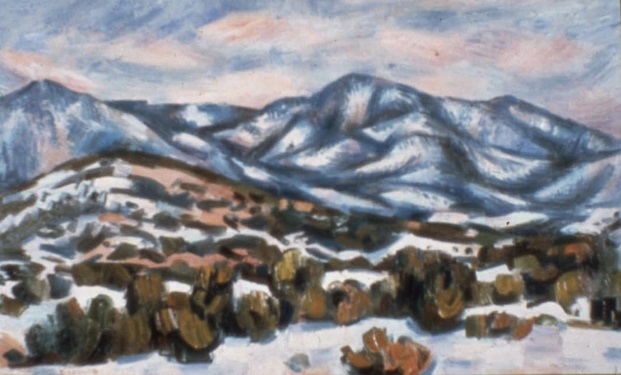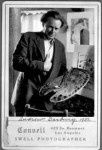
Andrew Michael Dasburg
French, 1887-1979 (active America)
Winter Landscape: New Mexico, 1931
oil on canvas
SBMA, Gift of Mr. and Mrs. Dalzell Hatfield for the Donald Bear Memorial Collection
1958.43

"In those days, Taos was a great simplicity. There was none of all this hallybaloo of advertising going on or any of hat sort of thing. There were other painters here who had come before, you know, like Cloust and Bloominshine and Sharpe and those earlier painters. They were here. But there were only two or three cars at he time in Taos; there was a good deal of horseback riding and wagons, mostly transportation was by wagon." - Oral history interview with Andrew Dasburg, 1974, Archives of American Art, Smithsonian Institution
RESEARCH PAPER
Winter Landscape: New Mexico is an oil on canvas (18” x 24”) and was a gift to the Santa Barbara Museum of Art’s Donald Bear Memorial Collection by the Dalzell Hatfield Gallery of Los Angeles in 1958. It was painted in December 1931, shortly after the artist had moved to New Mexico.
Dasburg’s winter landscape is a flowing mountain vista done in blues ranging almost to a purple, mantled with white. The foreground of gentle hills has heavy dark green and rust foliage done in impasto. The sky is lighted with patches of warm rose, leaving the viewer to decide whether it is early morning or evening. Suggestions of rock formations and buildings complete the scene.
Andrew Dasburg was born May 4, 1887 in Paris, France. He came with his parents to the United States in 1892. As a boy in New York he studied painting under very strict teachers who allowed the artist no freedom of expression. Dasburg believed this crippling to young artists and, because of the experience, has been interested in the teaching of art all of his adult life.
As a young man in the early 1900’s he journeyed to Europe to study the Impressionists and Post Impressionists. He visited Gauguin, Matisse and Cezanne. As a result of this influence he developed a method of using light and dark effects similar to Van Gogh. He moved away from presenting nature as recognizable objects. He decided that objects became a barrier to the viewer as each person brings with him a preconceived idea of what those objects should look like. “Dasburg wanted to create experiences.” He also experimented with Cubism and his later work reflects this influence. He said he was more interested in evoking emotions than in opening windows on the world.
In 1916 he visited Santa Fe and Taos, New Mexico, a visit that changed his life. He finally moved there in 1930. In 1932 he was awarded a Guggenheim Fellowship to study in Mexico. From that time his painting shows an influence of Old Mexico. Dasburg used as his model Cezanne’s treatment of Provence, which in some ways resembles Cezanne’s paintings of his favorite subject, Mont St. Victoire. Dasburg prefers to work directly from nature, adding the finishing touches in his studio.
In spite of suffering from Addison’s disease from about 1939 to 1949, during which time he did not paint, he won many awards and been exhibited widely. His first works appeared in the Armory Show in New York City in 1913. He then went on to win top prizes at the Pan American Exhibit in Los Angeles in 1925 and at the top International Carnegie Exhibition in Pittsburgh in 1927 and 1931. In 1957 the Dallas Museum of Fine Arts exhibited 120 of his works in an Andrew Dasburg Show.
Prepared for the Docent Council of SBMA by Jeanne Warden.
Notes
1. Jerry Bywaters, “Andrew Dasburg” (catalog) American Federation of Arts, New York, 1959, p.13
2. Ibid
Bibliography
Bywaters, Jerry. “Andrew Dasburg” (catalog) American Federation of Arts, New York, 1959.
Myers, B.S. (Editor) McGraw Hill Dictionary Of Art, Vol. 2, McGraw Hill CO., New York, 1969.
Rose, Barbara (Editor) Readings in American Art Since 1900, New York, 1968.
The Staff, Dallas Museum of Fine Arts (catalog), March 3- April 21, 1957, Dallas, Tex.
The Staff, “Drawings by Andrew Dasburg,” (catalog) University of New Mexico, Albuquerque, New Mexico 1964.
